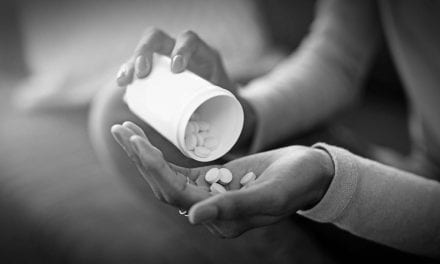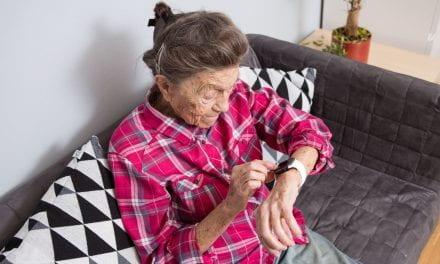Treatment and Recovery: Getting Healthy and Then Working on it Every Day
The Milton S. Hershey Medical Center – Health and Human Development Partnership
For the last decade, H. Harrington “Bo” Cleveland, professor of human development and family studies, has worked with researchers at Penn State’s College of Medicine to improve treatment and support recovery for people who are addicted to opioids. He has collaborated with Penn State College of Medicine researchers Sue Grigson and Scott Bunce on two large projects, one of which recently completed data collection and one of which will begin data collection next year.
In both research projects, the team works with individuals receiving inpatient care at Caron Treatment Center, a substance abuse rehabilitation facility in Wernersville, Pennsylvania. The research is led by the team’s medical doctors and clinicians, and the primary focus is on improving treatment for opioid addiction. Their goal is to understand how disruptions to a person’s biological systems can impact whether or not treatment succeeds. Cleveland and Timothy Brick, assistant professor of human development and family studies, joined the research project to learn how people’s behaviors, emotions, and cravings during withdrawal can influence whether they enter and sustain recovery.
Relapse, or returning to using opioids, is very common, and the reasons for relapse are complex. In order to gather data from people in such a delicate state, the researchers use smartphones to prompt participants four times a day, gathering real-time information about their emotions, level of drug craving, and social interactions.
One Day at a Time
“When I started studying recovery,” Cleveland explained “I wanted to understand how it worked on a daily basis. This idea was based on the well-known mantra in twelve-step recovery programs that says, ‘Live one day at a time.’ This means that you have to make it every single day. You have to maintain and support your recovery every single day.”
Cleveland took the then unusual approach of examining recovery data gathered each day. The data originally were collected on Palm Pilots (handheld electronic organizers), and Cleveland turned to smartphones once they became available.
By using digital technology to gather information about emotions, craving, and mood several times per day, the data can be looked at on different levels.
One level is the person level. Every person experiences withdrawal differently, with some people having more intense cravings or worse moods than other people throughout the study.
The data can also be considered at the daily level. Everyone has good and bad days, and this is reflected by comparing a person’s data on one day to their data on other days.
The third level is time of day. The data can be examined to see (among other things) if people’s moods or cravings are generally higher in the morning, afternoon, or evening.
How to seek treatment
If you or someone you know is struggling with substance use, help is available.
The United States Substance Abuse and Mental Health Services Administration (SAMHSA) maintains a confidential, free helpline for finding substance use treatment and information.
Call 1-800-662-4357.
What did we learn?
In the first study at Caron, the team found that generally, people’s cravings diminish over time in treatment. But this pattern does not hold up for everyone. Around 15 percent of study participants actually experienced intensifying cravings as time passed from detox.
Cravings vary more over the course of a single day than they do between days. In other words, the changes in cravings and mood that people experienced within any given day tended to be larger than the changes they experienced between one day and the next. There was a general trend that individuals experienced increased cravings throughout the day, and these cravings eased somewhat during the evening as people relaxed.
Preliminary findings show that people whose cravings strengthen when they are in a bad mood are in greater danger of relapse. This finding, if confirmed, would allow treatment providers to intervene with patients whose cravings and bad moods were linked. This could potentially help prevent relapses.
If we can predict relapse, then people in recovery could use an app like the one used by these researchers. This app data could alert a recovery specialist who could intervene with individuals when they are in danger of relapse. This could be particularly valuable in rural areas without an abundance of recovery-support services.
The Importance of Focusing on Recovery
Though this overall research project focuses primarily on treatment, Cleveland’s work always keeps recovery in mind. Without proper medical treatments people with substance use disorders—especially people addicted to alcohol or opioids—could go through painful and dangerous withdrawal. Furthermore, many people with dependencies on substances may never be able to achieve recovery without the support of treatment. Recovery, however, involves both continued abstinence and building overall wellbeing. It requires life changes and sustained efforts to maintain and protect wellbeing across time.
“In some ways, there is a disconnect between treatment and recovery. A lot of people find recovery without treatment. Others experience treatment without going into recovery. So, although we need to do a better job of getting people into treatment, we also need to do a better job of supporting recovery.”
Cleveland believes that society needs to stop thinking about treatment and recovery as short-term events and embrace a continuing care model of recovery, much as is provided with other chronic diseases. By supporting people in recovery longer, we will create a healthier, more productive society.
“Though both are vitally important, there has been much more research on treatment than on recovery in our society. There is an assumption that people go through a standard progression with addictive substances from use, to misuse, to addiction, to treatment, and then to recovery. Very often people who find recovery never go through an inpatient treatment program or any professional treatment for that matter.”
We Are… Committed to Building a Healthier Society
Health and Human Development (HHD) researchers are engaged in collaborations that are addressing substance use problems on multiple fronts, including the science of prevention, treatment, and recovery. For each researcher mentioned in this piece, there are a dozen others working on different aspects of substance use and addiction. As the Consortium to Combat Substance Abuse grows and matures, those collaborations will become more common and more impactful.
In addition, many HHD researchers have quickly modified their work so that they can address problems of substance use during the time of a global pandemic. This unprecedented time, when so many people are facing economic challenges and increased anxiety, will surely have many long-term consequences – including the potential for people to misuse substances at increased rates.
Erica Usher, Prevention Supervisor for the Fayette County Drug and Alcohol Commission, reflected on how community and university partnerships are making a difference. In Fayette County, every public middle school now has some form of life skills instruction, either through PROSPER or other programs.
“These programs have only spread across the entire county in the last couple of years,” Usher explained. “And that is only because of the work that PROSPER is doing, partnered with what the Drug and Alcohol Commission is doing, partnered with what our Communities that Care Coalition is doing. This would not have happened without all of those organizations working together simultaneously on the same problem.”
Society faces myriad problems posed by substance misuse, and there is no magic solution for all of them. By leveraging the diverse research expertise across HHD and Penn State, and by forging meaningful partnerships with communities, we are moving closer to real solutions for those suffering from addiction and providing a better life for those who might never have to suffer.





